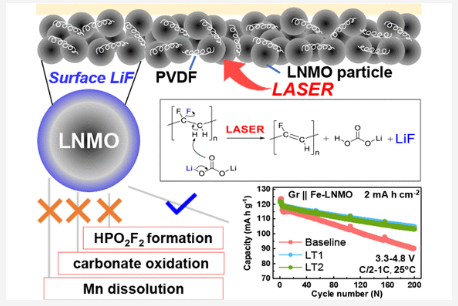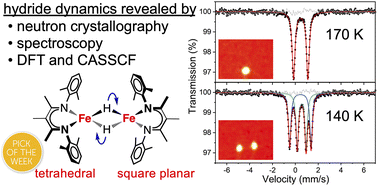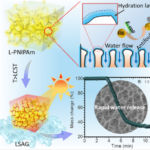2023-02-08 ノースカロライナ州立大学(NCState)
◆ナノ秒パルスレーザーアニーリングと呼ばれるこの技術は、わずか100ナノ秒の間に、現代の目の手術に使用されているのと同じ種類のレーザーで発生させることができる。研究者らは、この技術をリチウムイオン電池の負極(プラス極)に広く使用されているグラファイトでテストした。10パルスと80パルスのバッチで実験し、電流容量の違いを比較した。
◆NC州立大学のJay Narayan教授は、「材料欠陥は厄介なものですが、正しく設計すれば、それを利点にすることができます。この技術は、いわばリチウムイオンの扉を開くものであり、電流容量を向上させることができるのです」。グラファイトアノードは、表面に段差と溝があります。段差を増やすことは、リチウムイオンが出入りするためのドアを増やすようなもので、これは有益なことなのです。”この技術では、空孔と呼ばれる原子が欠けた欠陥も作ります。”これは、リチウムイオンが出入りする場所を増やすのに役立ち、電流容量に関係します。80パルスよりも10パルスに近い最適なパルス数を使用した場合、電流容量が20%増加しました。
◆しかし、この研究では、グラファイト負極の欠陥が多すぎると問題が生じることも示されました。「リチウムイオンは正電荷を帯びているので、電子を取り込むとリチウム金属になりますが、これは好ましくありません」とナラヤンは言う。「リチウム金属は、グラファイト陽極から小さなワイヤー状の樹枝状突起を放出し、火災の原因となる。だから、リチウムイオンが金属にならないようにしたいのです」。
◆テキサス大学オースティン校のナラヤンと同僚達は、最近、正極材料に同じレーザー技術を使った別の論文を発表しています。ACS Applied Materials and Interfaces誌に掲載されたこの研究では、レーザー処理によって正極材料が強化されることが示されました。
<関連情報>
- https://news.ncsu.edu/2023/02/defects-improve-lithium-ion-battery-performance/
- https://www.sciencedirect.com/science/article/abs/pii/S000862232300009X
- https://pubs.acs.org/doi/10.1021/acsami.2c18918
リチウムイオン電池の高性能化に向けたパルスレーザーアニールによる黒鉛負極の微細構造・欠陥エンジニアリング。 Microstructure and defect engineering of graphite anodes by pulsed laser annealing for enhanced performance of lithium-ion batteries
Author links open overlay panelNayna Khosla a, Jagdish Narayan a, Roger Narayan a b, Xiao-Guang Sun c, Mariappan Parans Paranthaman c
https://doi.org/10.1016/j.carbon.2023.01.009
Abstract

Nanosecond pulsed laser annealing significantly improves cyclability and current carrying capacity of lithium-ion batteries (LIBs). This improvement is achieved by engineering of microstructure and defect contents present in graphite in a controlled way by using pulsed laser annealing (PLA) to increase the number density of Li+ ion trapping sites. The PLA treatment causes the following changes: (1) creates surface steps and grooves between the grains to improve Li+ ion charging and intercalation rates; (2) removes inactive polyvinylidene difluoride (PVDF) binder from the top of graphite grains and between the grains which otherwise tends to block the Li+ migration; and (3) produces carbon vacancies in (0001) planes which can provide Li+ charging sites. From X-ray diffraction data, we find upshift in diffraction peak or reduction in planar spacing, from which vacancy concentration was estimated to be about 1.0%, which is higher than the thermodynamic equilibrium concentration of vacancies. The laser treatment creates single and multiple C vacancies which provide sites for Li+ ions, and it also produces steps and grooves for Li+ ions to enter the intercalating sites. It is envisaged that the formation of these sites enhances Li+ ion absorption during charge and discharge cycles. The current capacity increases from an average 360 mAh/g to 430 mAh/g, and C–V shows significant reduction in SEI layer formation after the laser treatment. If the vacancy concentration is too high and charge-discharge cycles are long, then trapping of electrons by Li+ may occur, which can lead to Li0 formation and Li plating causing reduction in current capacity.
長寿命リチウムイオン電池用高電圧スピネルLiNi0.5Mn1.5O4正極のレーザー支援表面フッ化リチウム化学修飾法 Laser-Assisted Surface Lithium Fluoride Decoration of a Cobalt-Free High-Voltage Spinel LiNi0.5Mn1.5O4 Cathode for Long-Life Lithium-Ion Batteries
Zehao Cui, Nayna Khosla, Tianxing Lai, Jagdish Narayan and Arumugam Manthiram
ACS Applied Materials and Interfaces Published:December 27, 2022
DOI:https://doi.org/10.1021/acsami.2c18918

Abstract
High-voltage spinel LiNi0.5Mn1.5O4 (LNMO) is a promising next-generation cathode material due to its structural stability, high operation voltage, and low cost. However, the cycle life of LNMO cells is compromised by detrimental electrode–electrolyte reactions, chemical crossover, and rapid anode degradation. Here, we demonstrate that the cycling stability of LNMO can be effectively enhanced by a high-energy laser treatment. Advanced characterizations unveil that the laser treatment induces partial decomposition of the polyvinylidene fluoride binder and formation of a surface LiF phase, which mitigates electrode–electrolyte side reactions and reduces the generation of dissolved transition-metal ions and acidic crossover species. As a result, the solid electrolyte interphase of the graphite counter electrode is thin and is composed of fewer electrolyte decomposition products. This work demonstrates the potential of laser treatment in tuning the surface chemistry of cathode materials for lithium-ion batteries.



